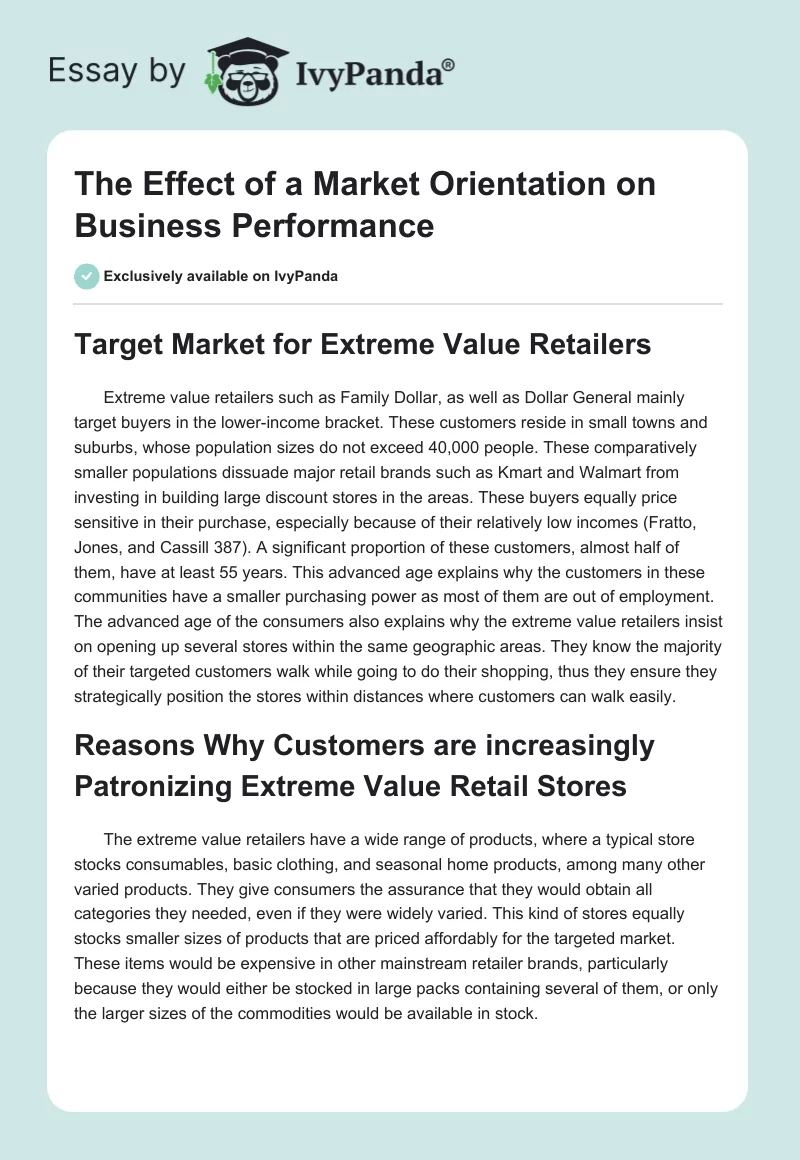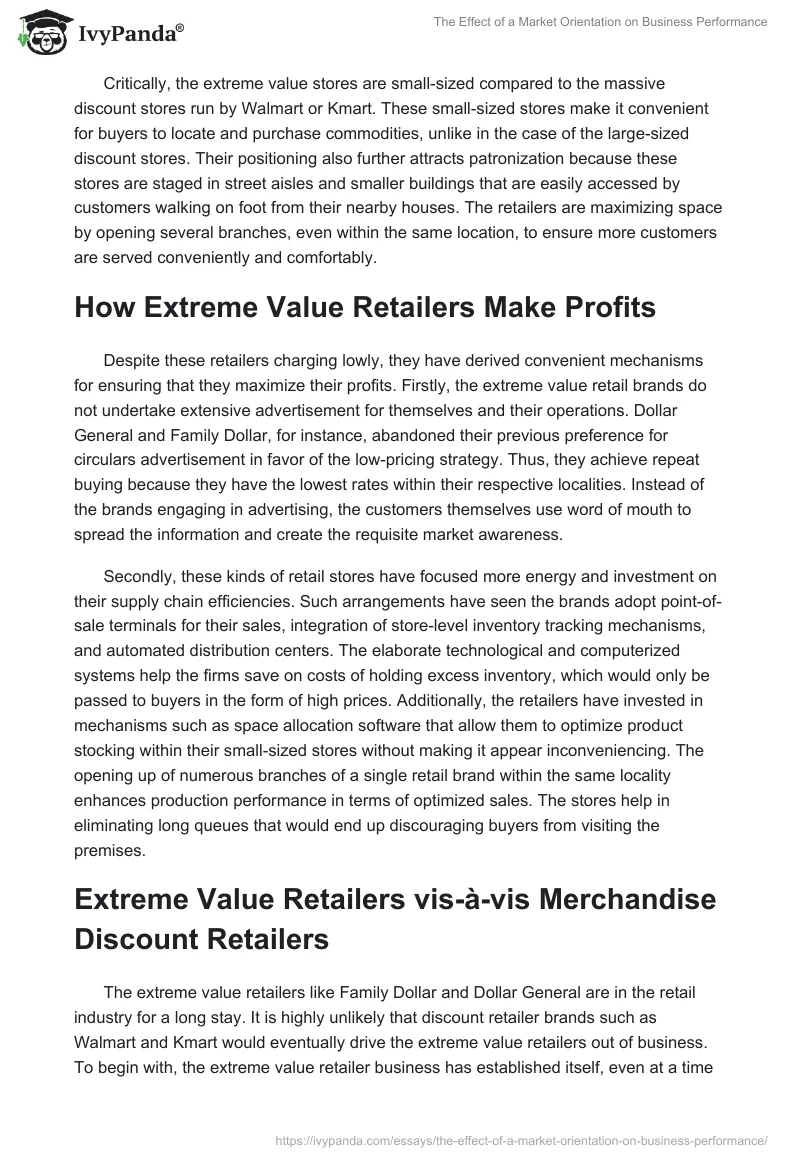Target Market for Extreme Value Retailers
Extreme value retailers such as Family Dollar, as well as Dollar General mainly target buyers in the lower-income bracket. These customers reside in small towns and suburbs, whose population sizes do not exceed 40,000 people. These comparatively smaller populations dissuade major retail brands such as Kmart and Walmart from investing in building large discount stores in the areas. These buyers equally price sensitive in their purchase, especially because of their relatively low incomes (Fratto, Jones, and Cassill 387). A significant proportion of these customers, almost half of them, have at least 55 years. This advanced age explains why the customers in these communities have a smaller purchasing power as most of them are out of employment. The advanced age of the consumers also explains why the extreme value retailers insist on opening up several stores within the same geographic areas. They know the majority of their targeted customers walk while going to do their shopping, thus they ensure they strategically position the stores within distances where customers can walk easily.
Reasons Why Customers are increasingly Patronizing Extreme Value Retail Stores
The extreme value retailers have a wide range of products, where a typical store stocks consumables, basic clothing, and seasonal home products, among many other varied products. They give consumers the assurance that they would obtain all categories they needed, even if they were widely varied. This kind of stores equally stocks smaller sizes of products that are priced affordably for the targeted market. These items would be expensive in other mainstream retailer brands, particularly because they would either be stocked in large packs containing several of them, or only the larger sizes of the commodities would be available in stock.
Critically, the extreme value stores are small-sized compared to the massive discount stores run by Walmart or Kmart. These small-sized stores make it convenient for buyers to locate and purchase commodities, unlike in the case of the large-sized discount stores. Their positioning also further attracts patronization because these stores are staged in street aisles and smaller buildings that are easily accessed by customers walking on foot from their nearby houses. The retailers are maximizing space by opening several branches, even within the same location, to ensure more customers are served conveniently and comfortably.
How Extreme Value Retailers Make Profits
Despite these retailers charging lowly, they have derived convenient mechanisms for ensuring that they maximize their profits. Firstly, the extreme value retail brands do not undertake extensive advertisement for themselves and their operations. Dollar General and Family Dollar, for instance, abandoned their previous preference for circulars advertisement in favor of the low-pricing strategy. Thus, they achieve repeat buying because they have the lowest rates within their respective localities. Instead of the brands engaging in advertising, the customers themselves use word of mouth to spread the information and create the requisite market awareness.
Secondly, these kinds of retail stores have focused more energy and investment on their supply chain efficiencies. Such arrangements have seen the brands adopt point-of-sale terminals for their sales, integration of store-level inventory tracking mechanisms, and automated distribution centers. The elaborate technological and computerized systems help the firms save on costs of holding excess inventory, which would only be passed to buyers in the form of high prices. Additionally, the retailers have invested in mechanisms such as space allocation software that allow them to optimize product stocking within their small-sized stores without making it appear inconveniencing. The opening up of numerous branches of a single retail brand within the same locality enhances production performance in terms of optimized sales. The stores help in eliminating long queues that would end up discouraging buyers from visiting the premises.
Extreme Value Retailers vis-à-vis Merchandise Discount Retailers
The extreme value retailers like Family Dollar and Dollar General are in the retail industry for a long stay. It is highly unlikely that discount retailer brands such as Walmart and Kmart would eventually drive the extreme value retailers out of business. To begin with, the extreme value retailer business has established itself, even at a time when the discount retailers were operational. This shows the fact that the discount retailers failed to cater to the overall market needs and demands, thus the extreme value retailers sufficed to fill the void. Although Walmart’s main policy is to maintain low prices every day, same as the extreme value retailers, the latter have taken the cue to move all the way to the grassroots to meet the poor customers.
The discount retailers remain positioned in the major cities and towns where their main target is to benefit from economies of scale advantages. This dissuades them from considering the smaller suburban and rural localities as potential markets because they may never attain the necessary levels of sales volume. Thus, inasmuch as the merchandise discount retailers concentrate on large markets and ignore the smaller ones, the extreme value retailers will continue doing business as they serve their target market satisfactorily (Kara, Spillane, and DeShields 105).
Works Cited
Kara, Ali, John E. Spillan, and Oscar W DeShields Jr. “The Effect of a Market Orientation on Business Performance: A Study of Small-Sized Service Retailers using MARKOR Scale.” Journal of Small Business Management 43.2 (2005): 105-118. Print.
Fratto, Genessa M., Michelle R. Jones, and Nancy L. Cassill. “An Investigation of Competitive Pricing among Apparel Retailers and Brands.” Journal of Fashion Marketing and Management 10.4 (2006): 387-404. Print.


